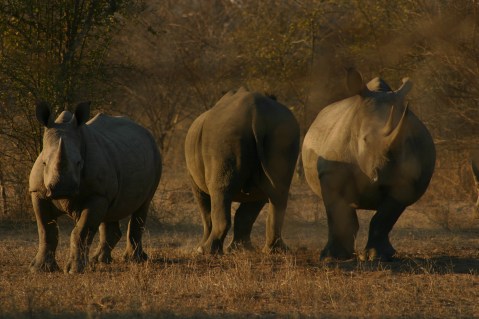Save The Rhino Day
Today’s blog is by Sarah Huebner, a first year PhD student at University of Minnesota’s Lionlab studying under Dr Craig Packer. She writes about Save the Rhino day that was celebrated this week.

Southern White Rhino. Photo: Lucy Hughes
May 1st, 2017 is Save the Rhino Day, a day on which we must ponder what can be done to pull this beautiful animal back from the brink of total destruction. With fewer than 25,000 rhinos remaining in Africa, there is a strong possibility that they could go extinct within our lifetimes if poaching continues at its current pace. In addition to the problems of habitat fragmentation and human-wildlife conflict that all African animals face, rhinos have a target on their backs from poachers and criminal elements seeking to profit from selling their horns.
There are two species of rhinoceros in Africa–black rhinos and white rhinos. Both black and white rhinos have two horns on their heads, a larger one in front and a shorter one behind it. It is estimated that there are only 5,000 black rhinos remaining, down from 850,000 in the mid-20th century. The reason for this dramatic population collapse is poaching and sale of their horns through a criminal network from Africa to Asia. Though the rhino was added to the CITES list of animals banned from trade in 1977, their numbers have continued to crash since then. This is primarily due to the demand in China, Vietnam, and North Korea for use of the horns in jewelry, carvings, as a status symbol, and even in medicine. Some people believe that rhino horn can cure cancer. Scientific evidence clearly shows that rhino horn, made from the same material as our fingernails, is not at all useful in medicine.
Perhaps most distressing is the news that the ban on rhino horn trade in South Africa, home to the largest extant population of rhinos, has been lifted by their court system, clearing the way for the legal export of rhino horns. This does not mean that illegal trade will cease. Indeed, this move gives even more cover to the criminals trafficking rhinos. Though rhinos have the ability to regrow their horns, most are killed before having their horns sawed off, as we saw in the horrifying incident at a French zoo recently. If the rhinos are still alive when the horns are removed, they suffer terrible pain and are left to die, which many do because of blood loss. Impoverished poachers in Africa make very little for their efforts, while importers and sellers in Asia can make as much as US$30,000 for one kilogram of horn. Some estimate that the sale of both the front and back horns together is worth US$250,000. This makes rhino horn more valuable than gold or platinum. Little wonder that private reserves in South Africa wish to profit from the sale of these animals’ parts.
How then do we stop this? Organizations such as the Wildlife Justice Commission and Outraged South Africa Citizens Against Poaching are working to expose the criminal networks responsible for the poaching, smuggling, and selling of these horns in Asia. We can aid these and other conservation groups by helping to finance their initiatives designed to curb poaching. Perhaps the best way we can take action is to pressure our own governments to enact diplomatic sanctions on the countries that continue to look the other way while rhino horns are smuggled across their borders–primarily China, Vietnam, and North Korea. Diplomatic acts such as sanctions, travel bans, and blacklisting by other countries could convince these governments to enforce the national and global laws already on the books concerning rhino horn. On Save the Rhino Day 2017, contact your representatives and tell them that you want them to use diplomatic methods to pressure these countries to stop the import of rhino horn. Or the only way our children and grandchildren will see rhinoceros is in pictures, as we tell them about the magnificent creatures that once walked the earth.
Wildlife Justice Commission: https://wildlifejustice.org/
Outraged South African Citizens Against Poaching: http://vyhub.com/css/css/
Investigative journalism by Al Jazeera: https://www.youtube.com/watch?v=JMguWY99q6s
NYTimes–South African Court Ends Ban on Sale of Rhinoceros Horns: https://www.nytimes.com/2017/04/05/world/africa/south-africa-rhinoceros-horns-rhinos.html?_r=0
